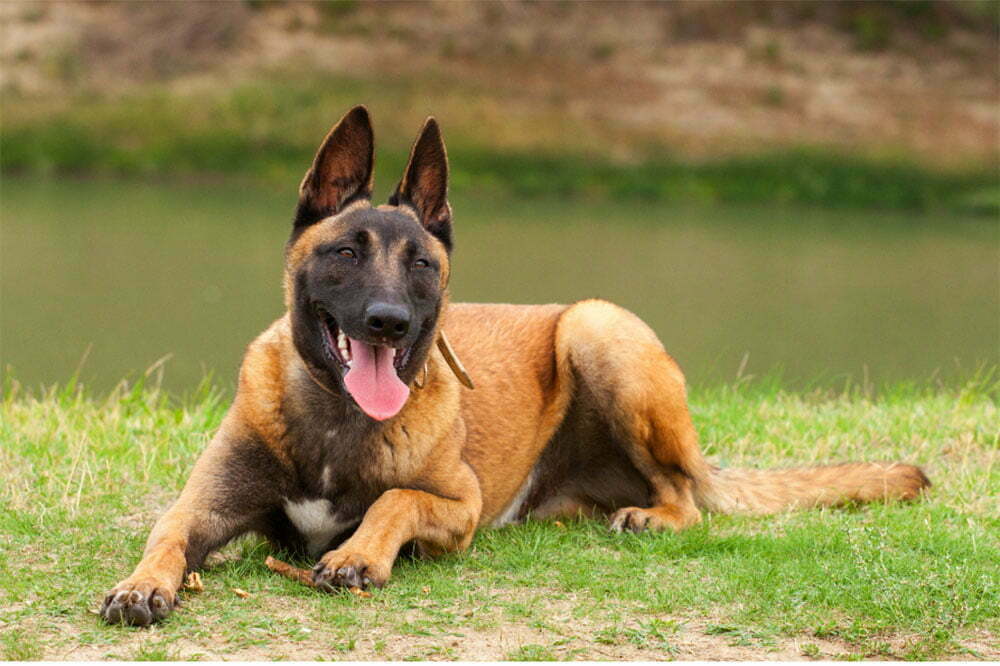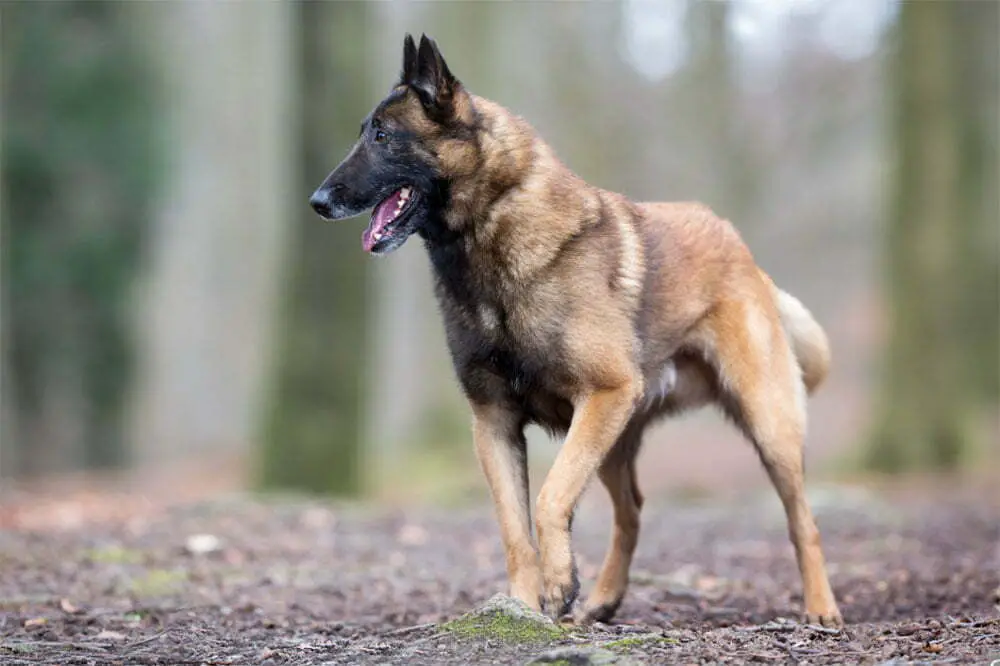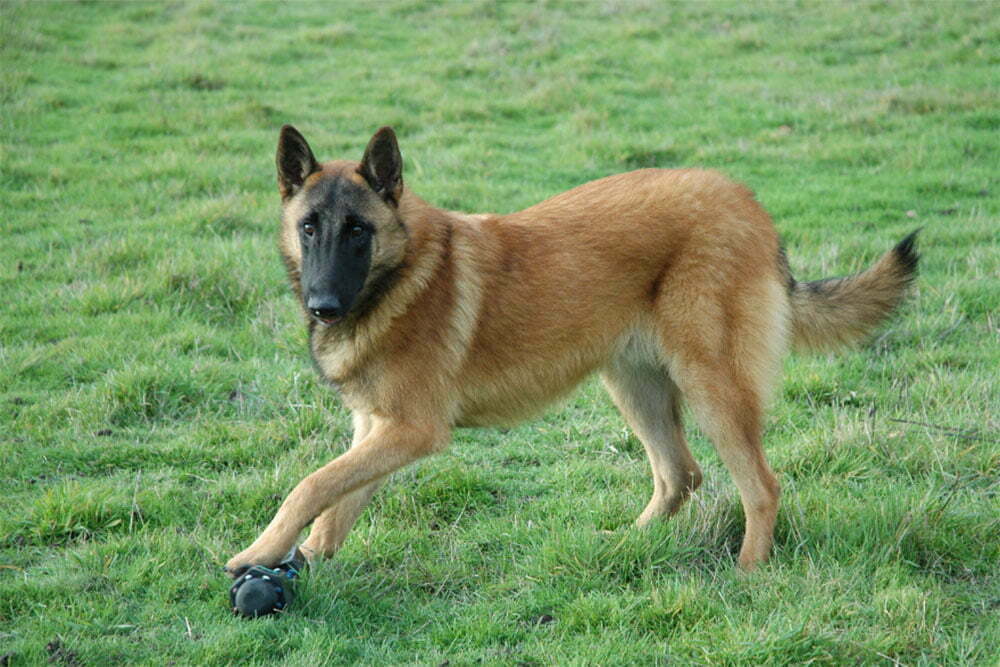Often confused with German shepherds, the Belgian Malinois (pronounced mal-in-wah) is a medium sized shepherd dog originating from Belgium.
These dogs typically have short fawn colored, brown, or red fur with a black mask. Belgian Malinois are highly energetic dogs that are widely used for police work, search and rescue, and for agility events.
At first glance, Belgian Malinois appear very similar to German shepherds. However, the breeds have different physical builds to mark them apart. Belgian Malinois are much smaller than German shepherds.

They have lighter bones, and stand with their weight distributed onto their toes, giving them more of a square appearance.
German shepherds, however, carry their weight flatter on their feet, and they have a sloping back.
If you put a Belgian Malinois and a German shepherd next to each other, it should be fairly easy to tell the difference. German shepherds have a different coloring, and the two breeds have differently shaped heads.
Key Facts
Here are some of the key facts about Belgian Malinois if you want to learn more about this breed.
Average lifespan
The average lifespan of a Belgian Malinois is anywhere between 12 to 16 years. This will depend on how fit and healthy your dog is, how much exercise they have, whether they have a healthy balanced diet, and how well their needs are met.
Minimum exercise (per day)
Belgian Malinois need a lot of exercise. These are highly energetic dogs, and need a lot of training so they can blow off some steam. These dogs were originally bred to be herding dogs, so they need to live a very active lifestyle.
Malinois will need to be in a home where they will get lots of active exercise every day. This is partially why they make such great working dogs and are used in a variety of professions across the United States.
Coat length
Malinois have fairly short fur, which makes them one of the easier dogs to groom. You won’t have to take this dog to the groomer’s every week to ensure their coats are well maintained.
Minimum cost (per month)
The main costs that you will have to factor into owning a Belgian Malinois are food, treats, and poop bags. This shouldn’t cost you more than around $80 a month.
Another factor to consider is whether you want to take your Malinois to agility classes, in which case this may be another price to factor on top of the monthly maintenance. Another factor to consider is the cost of deworming and flea treatment, which will be around $50 a month.
Appearance
As we’ve already discussed, this breed appears very similar to a German shepherd at first glance. But there are a few differences that make them stand out.
Size
Malinois are one of the larger breeds of dog. This means they will need a lot of space to run around in, so you will need a backyard that has plenty of room to accommodate their needs.
Average height
Belgian Malinois have a typical height of around 22 to 26 inches when their height is measured at the shoulder. This makes them one of the taller breeds of dog.
Average weight
Malinois have an average weight of between 40 to 80 pounds. This will differ depending on the dog’s gender, how active they are, and whether they have a healthy, balanced diet.
Temperament
On the whole, Belgian Malinois are a friendly breed that lend themselves well to family life. They are intelligent dogs that are fairly easy to train, and will be better suited to those who have some experience with dogs.
Here are a few facts to bear in mind when it comes to deciding whether a Belgian Malinois will be the perfect fit for your home.
Apartment living
This is one of the larger breeds of dog, and they are highly energetic. This means that the Belgian Malinois isn’t really suited to apartment living.
They don’t do well in cramped spaces, so you will need to have a home large enough to accommodate their needs. They will also be better suited to homes with large open spaces for your dog to run around in.
Good for novice owners
Belgian Malinois are not best suited for novice owners because of their highly energetic nature.

This breed will be better suited for dog owners who have more experience and will be able to handle their energy. This breed will also be better suited for those who have experience with dog training.
Sensitivity level
This is a breed that won’t respond well to harsher training methods. They are quite sensitive dogs, and are usually friendly and assertive. This high sensitivity level means that a Belgian Malinois won’t be best suited to noisy households with young children.
Tolerates being alone
The Belgian Malinois is able to tolerate being left alone for some period of time. They’re not an overly anxious dog that’s likely to wreck your house if you need to pop to the store.
They won’t become too stressed each time you have to leave. However, they won’t like being left on their own for hours and hours.
Tolerates cold weather
This breed may have a shorter coat, but their fur is still pretty thick. This means they’ll be able to tolerate a fair amount of cold weather, providing they’re not left outside in freezing temperatures.
Your Belgian Malinois should be able to cope with a lengthy walk in colder weather without becoming too distressed.
Affectionate with family
These are highly affectionate, loving dogs. Your Belgian Malinois is a friendly breed that will get excited to spend time with all the family. They’re not overly prone to aggression, so you won’t have to worry about them snapping at anyone who gets too close.
This makes them a great fit as a family pooch, providing you can meet their daily needs for exercise. The Belgian Malinois is a very friendly dog that will be very protective of your family unit.
Kid friendly
Belgian Malinois are fairly kid friendly as a breed. It will be worth remembering that they are larger dogs who are fairly sensitive, so aren’t the best to have in a household with loud, younger children.
These dogs will be better suited to families whose children are at least 8 years of age, or who understand when the dog needs their space.
Dog friendly
This breed isn’t the most friendly towards other dogs. You will need to make sure your dog is properly socialized, so that they don’t display any aggressive behavior towards other dogs.
It will also be important to introduce them to other dogs slowly, so that they can get used to one another. It will be best to keep them on the leash if you go to the dog park, and ensure that they will come to you when called to avoid any unfortunate incidents.
Friendly towards strangers
Your Belgian Malinois will be slightly friendlier towards strange humans than it will be to strange dogs, however, not by much.
If a stranger comes towards them with a treat or just to say hello, they will be friendly enough towards them. But they’re unlikely to become overly friendly at the idea of a stranger petting them. It will still be important to keep your dog on a lead.
Health and Grooming
Even though Belgian Malinois are a pedigree breed, they are generally much healthier than other pedigrees which have an abundance of health issues through inbreeding. Here are a few health and grooming facts to help you decide whether a Belgian Malinois will be ideal for your home.
Shedding
Belgian Malinois don’t shed as much as other breeds of dog. The shedding with this breed tends to mainly be seasonal, where they lose their thicker fur coat during the hot summer months.
Drooling
These aren’t dogs that are prone to drooling. If you’re looking for a dog that won’t dribble slobber all over your furniture, the Belgian Malinois will be a great fit for your home.
Grooming
This is a breed that will be fairly easy to care for. They don’t require a lot of grooming because of their shorter coats. You can brush them between 2 to 3 times a week if you want to keep on top of any seasonal shedding. There’ll be no need to worry about taking your dog to the groomers once a week.
General health
The great news is that Belgian Malinois are generally fairly healthy dogs. There is the potential for some health issues, however, providing the dogs are well cared for and their common needs are met, your Belgian Malinois should be able to live a healthy lifestyle without racking up too many vet bills.
Common health problems
Some of the more common health problems among Belgian Malinois are hip dysplasia, elbow dysplasia, cataracts, progressive retinal atrophy, pannus, and hemangiosarcoma.
Belgian Malinois is also a breed that has a high sensitivity to anesthesia. This is because of their muscle to fat ratio, so they have a higher than average death rate when put under anesthetic.
Potential for weight gain
On the whole, Belgian Malinois are highly energetic dogs. This means that even if they require a lot of food to meet their daily needs, they will likely burn off these calories during their daily exercise routine.
So this is a breed that isn’t all that likely to gain weight, unless they have a very unhealthy diet and aren’t getting as much exercise as they need during the day.
Trainability
Easy to train
Belgian Malinois are one of the easiest dogs to train. It is partly because of this fact that they are often used in the police force, as well as for search and rescue missions.

This is a very intelligent breed that will be able to quickly learn what you’re trying to teach them. It’s recommended to properly train your Belgian Malinois so that they can burn off some of their excitable energy. This breed is an eager learner, too, which makes them even easier to train.
Intelligence
This is a highly intelligent breed that is still used as a working dog. Belgian Malinois were originally developed as a herder dog in Belgium.
This intelligence has remained with the modern breed today, and lends itself well to certain professions. Your dog will need a lot of mental stimulation to keep them happy and healthy.
Potential to bite
The Belgian Malinois does have some potential for biting. They have been known to fear bite, or nip when excited. This will need to be a habit that you train out of them.
It will also be important to ensure that your Belgian Malinois has been properly socialized so that they will know this isn’t acceptable behavior. This will mean buying your puppy from a reputable breeder who won’t let you take the dog home until they’re at least 8 weeks old.
Tendency to bark or howl
If you’re looking for a fairly quiet dog, then the Belgian Malinois may be the breed for you. This is a breed that will only bark or howl when necessary.
They are highly loyal and protective dogs so will try to keep your family safe. They are only likely to bark or howl if they feel that your home is under threat of intrusion.
History
The Belgian Malinois is a breed with a very rich history. It was first developed in the Belgian city of Malines as a herder dog, back in the 1800s.
However, the breed wasn’t officially recognized until around 1901. While their original purpose was for herding sheep, they eventually became recognized for their intelligence, loyalty, and obedience.
These great qualities have meant that the Belgian Malinois have been used as a working dog for other occupations throughout history. They were used as draught dogs, guard dogs, and even used by the Belgian police.
During the first world war, the Belgian Malinois was drafted in for all manner of jobs. These dogs were used as messengers, ambulance cart dogs, and supposedly even as light machine gun cart dogs.
Belgian Malinois is a breed that’s risen in popularity throughout the 20th century.
During the 20s and 30s, they started to be one of the most exported dog breeds in Belgian. Because of their great temperament and trainability, many Americans brought them back to the United States.
This breed has been highly recognized for its intelligence and trainability in recent years. They have been used for drug detection, military, search and rescue operations, and the police force.
Costs
There are a couple of cost factors you will need to consider when it comes to adding a Belgian Malinois to your home. You will need to choose your puppy from a reputable breeder, so this should cost you anywhere in the region of $1,000 to $2,500 depending on the breeder themselves.
You shouldn’t try to pay any less than this, as you may be supporting a puppy mill or backyard breeder.
These people cut costs when it comes to caring for their dogs, and you could end up with an unhealthy, unsocialized dog in the meantime.
When it comes to factoring in the monthly costs once you’ve got your puppy home with you, it shouldn’t be more than around $80 a month for food, treats, and miscellaneous things such as poop bags and toys.
There may also be the odd vet bill every now and then each time they need to go for a checkup or vaccinations.
You will also need to consider things like deworming and flea treatments, which could cost around $50. It will be better off getting these from your vet, too, as much of the grocery store products won’t be as effective.
Another factor that will be worth considering is whether you want to take your new Belgian Malinois to agility classes. This will roughly cost you around $125 to $200 for a 6 session course.
If you’re concerned about any potential health issues your dog may encounter, it will be worth getting them pet insurance. This shouldn’t cost you more than around $40 a month.
Fun Facts
- Did you know that the Belgian Malinois is one of the fastest breeds in the world? It’s been recorded running up to 30mph
- The Belgian Malinois held some of the most important roles during the first world war. They helped the Red Cross, helped carry messages, and helped to pull ambulance carts
- The Belgian Malinois get their name from the city of Malines in Belgium where the breed was developed
- Because of this breed’s easy trainability and high intelligence, they are often used as working dogs in the police force
- Belgian Malinois were originally bred as herding dogs. They were one of four Belgian breeds bred for this purpose
- This breed is also used as part of the military. A Belgian Malinois was part of the SEAL Team 6 unit that was used to take down Osama bin Laden
